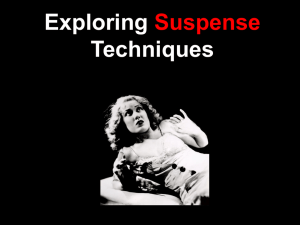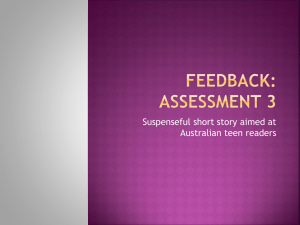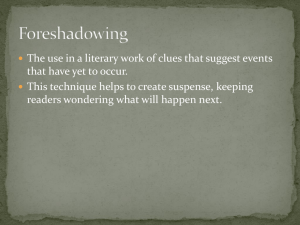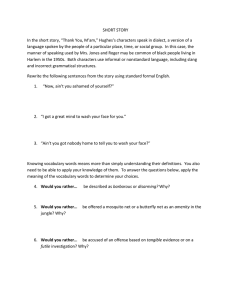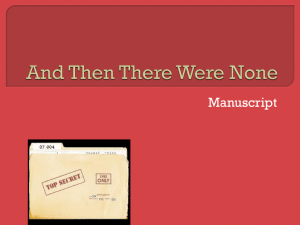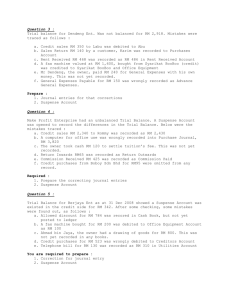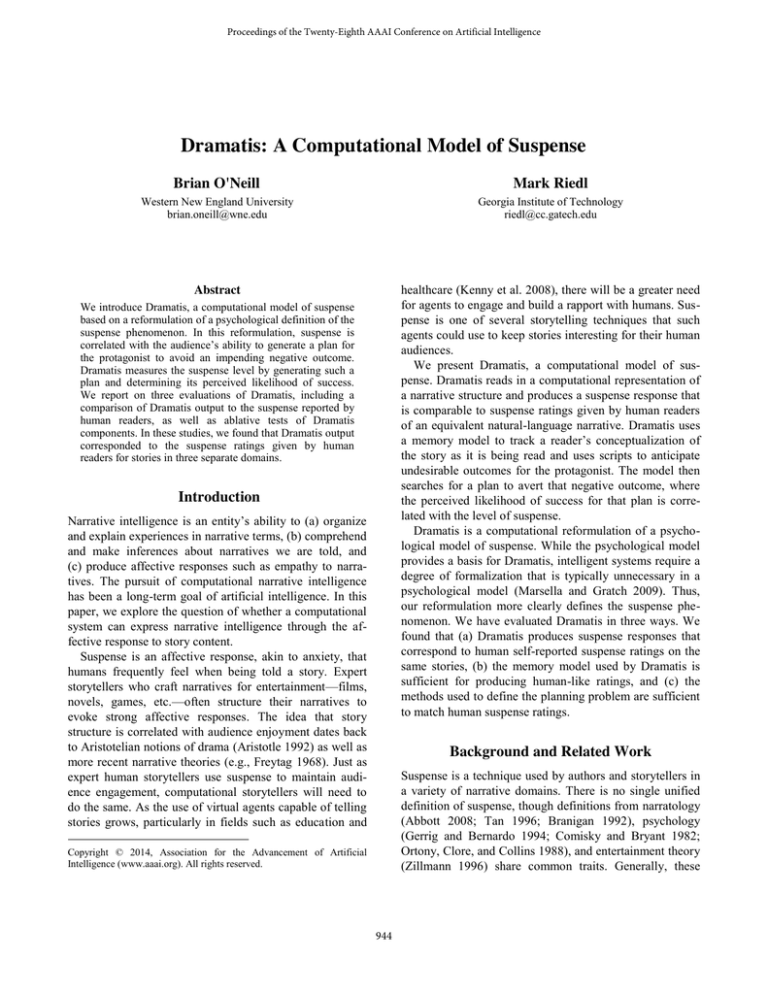
Proceedings of the Twenty-Eighth AAAI Conference on Artificial Intelligence
Dramatis: A Computational Model of Suspense
Brian O'Neill
Mark Riedl
Western New England University
brian.oneill@wne.edu
Georgia Institute of Technology
riedl@cc.gatech.edu
Abstract
healthcare (Kenny et al. 2008), there will be a greater need
for agents to engage and build a rapport with humans. Suspense is one of several storytelling techniques that such
agents could use to keep stories interesting for their human
audiences.
We present Dramatis, a computational model of suspense. Dramatis reads in a computational representation of
a narrative structure and produces a suspense response that
is comparable to suspense ratings given by human readers
of an equivalent natural-language narrative. Dramatis uses
a memory model to track a reader’s conceptualization of the story as it is being read and uses scripts to anticipate
undesirable outcomes for the protagonist. The model then
searches for a plan to avert that negative outcome, where
the perceived likelihood of success for that plan is correlated with the level of suspense.
Dramatis is a computational reformulation of a psychological model of suspense. While the psychological model
provides a basis for Dramatis, intelligent systems require a
degree of formalization that is typically unnecessary in a
psychological model (Marsella and Gratch 2009). Thus,
our reformulation more clearly defines the suspense phenomenon. We have evaluated Dramatis in three ways. We
found that (a) Dramatis produces suspense responses that
correspond to human self-reported suspense ratings on the
same stories, (b) the memory model used by Dramatis is
sufficient for producing human-like ratings, and (c) the
methods used to define the planning problem are sufficient
to match human suspense ratings.
We introduce Dramatis, a computational model of suspense
based on a reformulation of a psychological definition of the
suspense phenomenon. In this reformulation, suspense is
correlated with the audience’s ability to generate a plan for
the protagonist to avoid an impending negative outcome.
Dramatis measures the suspense level by generating such a
plan and determining its perceived likelihood of success.
We report on three evaluations of Dramatis, including a
comparison of Dramatis output to the suspense reported by
human readers, as well as ablative tests of Dramatis
components. In these studies, we found that Dramatis output
corresponded to the suspense ratings given by human
readers for stories in three separate domains.
Introduction
Narrative intelligence is an entity’s ability to (a) organize and explain experiences in narrative terms, (b) comprehend
and make inferences about narratives we are told, and
(c) produce affective responses such as empathy to narratives. The pursuit of computational narrative intelligence
has been a long-term goal of artificial intelligence. In this
paper, we explore the question of whether a computational
system can express narrative intelligence through the affective response to story content.
Suspense is an affective response, akin to anxiety, that
humans frequently feel when being told a story. Expert
storytellers who craft narratives for entertainment—films,
novels, games, etc.—often structure their narratives to
evoke strong affective responses. The idea that story
structure is correlated with audience enjoyment dates back
to Aristotelian notions of drama (Aristotle 1992) as well as
more recent narrative theories (e.g., Freytag 1968). Just as
expert human storytellers use suspense to maintain audience engagement, computational storytellers will need to
do the same. As the use of virtual agents capable of telling
stories grows, particularly in fields such as education and
Background and Related Work
Suspense is a technique used by authors and storytellers in
a variety of narrative domains. There is no single unified
definition of suspense, though definitions from narratology
(Abbott 2008; Tan 1996; Branigan 1992), psychology
(Gerrig and Bernardo 1994; Comisky and Bryant 1982;
Ortony, Clore, and Collins 1988), and entertainment theory
(Zillmann 1996) share common traits. Generally, these
Copyright © 2014, Association for the Advancement of Artificial
Intelligence (www.aaai.org). All rights reserved.
944
definitions claim that suspense requires uncertainty about a
particular outcome (on the part of the audience), where the
outcome is significantly desirable or undesirable.
This work is based on a modification of a psychological
perspective of suspense, provided by Gerrig and Bernardo
(1994). They argue that “readers feel suspense when led to believe that the quantity or quality of paths through the
hero’s problem space has become diminished.” Gerrig and
Bernardo describe a scene from Ian Fleming’s Casino
Royale novel, where James Bond, and readers thinking on
his behalf, attempts to traverse a problem space from the
current state (where a gun is held to his back), through a
series of intermediate states, to a goal state (where his life
is no longer in danger). Fleming introduces possible solutions, and immediately retracts them, thereby reducing the
quantity of paths available to Bond (and the readers).
Gerrig and Bernardo also note that authors can manipulate
the search space by making certain actions appear too
costly, thereby affecting the quality of paths in the space.
Of the various definitions of suspense, Gerrig and
Bernardo’s approach is the most amenable to a computational representation. The reader traversal of a problem
space on behalf of a story character described by their
model is analogous to the methods used in artificial intelligence to solve search problems. However, this model cannot be directly converted into a computational system; in
the next section, we describe modifications made to Gerrig
and Bernardo’s model of suspense in order to represent it
computationally.
Suspenser (Cheong 2007) is a discourse generation system that takes a given sequence of narrative events and
produces the most suspenseful re-ordering of those events,
possibly excluding events from the telling. Suspenser
generates all possible plans a protagonist could use, and
compares the ratio of failed plans to successful ones in
order to evaluate the level of suspense. As the ratio of
failed plans increases, the suspense level increases correspondingly. However, it is intractable to generate all possible plans for any sufficiently complicated story world
model. Further, potential paths through the search space
may terminate without reaching a solution for reasons that
are specific to planning algorithms rather than the nature of
the story world such as repeated states, lack of applicable
operators, and problems binding literals to operators.
A number of story generation systems and interactive
narrative systems use models of dramatic arc to guide the
generation process. However, to date all of these systems
require the human author to specify a fixed dramatic value
for different events and actions that can be added to the
story. These systems do not consider the question that
events may appear more or less dramatic (or suspenseful)
because of the context in which these actions or events are
used. The interactive drama, Façade, tracks tension as part
of managing the interactive narrative (Mateas 2002). The
Façade drama manager tries to match the tension of each
story state to an ideal tension curve. When the level of tension does not match the ideal curve, Façade probabilistically increases or decreases the tension in the story. The
level of tension only affects which presentation of events a
user sees, as each presentation conveys roughly the same
events. Porteous et al. (2011) also model tension in their
Merchant of Venice interactive storytelling system as a
means of forcing stories to conform to traditional
Aristotelian dramatic arcs. Interactive story authors can
also use this system to design ideal dramatic arcs to serve
as guides within their own narratives.
Reformulation of Suspense Definition
Creating a computational model of suspense requires a
formal model of suspense. While Gerrig and Bernardo’s model is suitable as a starting point, it is computationally
intractable for three reasons. First, simply counting the
paths that end in failures wrongfully assumes that all paths
that do not lead to a solution are the result of the story state
rather than the definition of the planning problem. Second,
the definition suggests that humans regenerate the search
space constantly and are in a perpetual state of feeling
some level of suspense. However, most accepted definitions of suspense require that the audience expect some
impending undesirable outcome in order to feel the phenomenon. Additionally, regenerating the search space requires consideration of the causal consequences of events,
an inference which is typically possible only during offline
processing (Graesser, Singer, and Trabasso 1994). Human
readers are not capable of frequent offline processing, and
therefore, a computational model of suspense should not
regenerate the search space constantly. Finally, there is no
evidence that human readers are capable of generating the
entire search space, and thus all paths to success or failure,
in part because humans are resource-bounded.
As a consequence of these insights into suspense and
computation, we reinterpret Gerrig and Bernardo’s description of suspense as a search space as follows:
Given the belief that the protagonist can face a
negative outcome, one can assume that outcome
will occur and search for the single most likely plan
in which the protagonist avoids that outcome.
We refer to such a plan as an escape plan. Further, where
Gerrig and Bernardo refer to the quality of a path through
the problem space, we define the quality of an escape plan
as its perceived likelihood of success. Using perceived,
rather than actual, likelihood allows us to consider the
means available to authors for manipulating the search
space. The perceived likelihood of an event is correlated
with how quickly it can be retrieved from memory. Humans perceive the first thought they retrieve as being most
945
likely to occur (MacLeod and Campbell 1992). Thus, a
human reader would first generate the escape plan that they
perceived as most likely to succeed. This approach does
not require repeated generation of the search space, because the search is conducted only when the audience expects a negative outcome for the protagonist. Searching for
a single plan avoids the need to generate the entire search
space and overcomes the issues with measuring the ratio of
failed plans.
ters’ plans that have been described within the story itself
as part of the time-slices (e.g., a villain’s monologue).
MEI-P Situation Model
As Dramatis reads the story, it adds story elements (such as
characters and locations) and events (represented by
STRIPS operators) to a memory model. We have implemented a memory model, Modified Event Indexing with
Prediction (MEI-P), based on psychological theories of
reader mental models. Zwaan et al. (1995) proposed Event
Indexing (EI) to model the change in readers’ conceptualizations of stories as they read. Niehaus (2009) proposed
the Modified Event Indexing (MEI) model to account for
narrative focus and the ability to draw inferences while
reading. MEI-P uses scripts to activate concepts in memory
based on future expectations.
The MEI-P situation model is a spreading activation
network, where greater activation indicates that a story
element is more salient in the reader’s memory. Thus a story element with strong activation is more easily retrieved. The cost of retrieval will be used to calculate the
perceived likelihood of actions used while constructing
escape plans.
When Dramatis reads a new time-slice of the story, it
creates a new node in MEI-P to represent the event in that
time-slice. This event node is connected to nodes representing the characters in the scene, the location of the
scene, the preconditions and effects of the event according
to its STRIPS representation, and any literals used in the
STRIPS representation. If such nodes did not already exist
within the MEI-P situation model, then new nodes are
added to the model. Each new edge in the network is given
a weight of 1.0, while pre-existing edges decay according
to their distance from the new event node. Node activation
is calculated by giving all nodes an activation of 1.0, then
iteratively spreading node weights according to edge
weights until activation stabilizes.
In addition to incorporating story events observed in
time-slices, MEI-P also includes events that are predicted
by the scripts identified earlier in the process. Any event in
the script that may occur after the most recently observed
event is added to the MEI-P situation model. The salience
of future events decreases with their distance from the current event, just as prior events become less salient over
time unless connected to more recent events.
Dramatis
Dramatis is a computational model of suspense that calculates the level of suspense over the course of a story according to the reformulation of Gerrig and Bernardo’s definition of suspense presented above. Dramatis reads
discretized symbolic-logic versions of stories, determines
whether characters are facing a negative outcome, and generates and evaluates the quality of an escape plan to avoid
that outcome. The evaluation of quality is equated to the
level of suspense at that moment in the story.
Dramatis reads stories in a discretized symbolic-logic
format called time-slices. Each time-slice describes one
action in the story, where the action is given as an instantiated STRIPS operator. Time-slices also contain information about the characters in the scene, the location of the
scene, and any effects of the action that cannot be inferred
from the STRIPS operator.
Predicting Negative Outcomes
As Dramatis reads each time-slice, it predicts whether
readers should expect any negative outcomes for the protagonist. To do this, the model relies on a library of scriptlike structures that represent the typical sequences in common story situations (e.g., a spy at a bar) and the negative
outcomes that frequently occur within those situations
(e.g., the spy getting poisoned). A script is a directed graph
in which nodes are possible events and arcs are of two
types. Temporal arcs indicate events that can follow other
events. Any path through temporal arcs is a possible way
the situation can unfold. Causal arcs indicate necessity
relations between events in the same temporal arc path, and
are labeled with the condition established by the first event
that is necessary for the second event to happen. Dramatis
uses the causal arcs to identify potential goals for the planning process in generating the escape plan.
When searching for relevant scripts, Dramatis prefers
scripts that make use of recent events and can be bound to
the actions in time-slices observed in the story so far. As
the story continues, Dramatis tracks the identified script,
maintaining a pointer to the most recently observed event
that was also part of the script. In lieu of scripts, Dramatis
can also glean similar information from opposing charac-
Generating Escape Plans
Dramatis’ suspense response is correlated with the perceived likelihood of success for escaping an impending
negative outcome. Dramatis generates the escape plan—a
plan that averts the negative outcome—that is perceived to
be most likely to succeed, and the cost of the plan is equivalent to the level of suspense. Dramatis generates an escape
946
the first evaluation, Dramatis generates suspense curves for
two versions of three stories, while human readers read and
rate the suspense levels of natural language versions of
these same stories. We report the level of agreement of
suspense ratings between Dramatis and human readers.
The second evaluation ablates the MEI-P situation model,
such that it is not used in calculating escape plan cost, and
therefore, the suspense rating. The suspense curves generated by the ablated system are compared to the human ratings generated in the first evaluation. In the final evaluation, we modify the algorithm for determining goal states
prior to escape planning, in order to demonstrate the necessity of the goal selection process.
These evaluations required pairs of stories with differing
levels of suspense. Thus, the evaluations use two versions
of three stories. Each pair contains an original version and
an alternate version, where details of the original version
were changed in a way that we believed would lower the
overall perception of suspense. The three story pairs were
adapted from scenes from the films Casino Royale, Rear
Window, and Harry Potter and the Half-Blood Prince.
The alternate versions of the stories were created by removing, reordering, or changing the details of the events of
the original version. The changes reduce suspense by
providing additional means of addressing the protagonist’s
problem or introducing solutions earlier. For example, in
the original Casino Royale scene, James Bond is poisoned
and attempts to cure himself. In the alternate version, we
introduce the antidote sooner, and we remove Bond’s failed attempt at curing himself. As a result, readers can
use the antidote in solutions sooner and retain multiple
possible solutions.
The operators and scripts used by Dramatis were
crowdsourced to avoid experimenter bias; details of our
crowdsourcing methodology for crowdsourcing scripts and
operators are beyond the scope of this paper. The
operators, scripts, and all versions of the stories used in
these evaluations are available in (O’Neill 2013).
plan as follows. First, the currently activated script is converted into a planning problem. The initial state is the current state of the story world as determined by the logical
formalism of the story. The goal situation is the negation of
any condition on any causal arc in any valid path through
the active script between the current state and the undesirable outcome. That is, any sequence of actions by the hero
that violates a causally necessary condition leading to a
negative outcome may avert that negative outcome.
The planning problem is solved with a modified version
of the Heuristic Search Planner (HSP) (Bonet and Geffner
2001), which can find near-optimal solutions for problems
with non-uniform costs. HSP is an informed state-space
search algorithm that uses a relaxed form of the planning
problem—ignoring delete lists in the STRIPS operators—
to estimate the cost of reaching a goal state. HSP requires
that the goal be stated as positive (non-negated) propositions. Because our goal situation is comprised of a number
of negated propositions ORed together, we modify HSP to
allow it to peek at the delete lists to determine if any operator can achieve the goal situation. HSP is not guaranteed
to return the optimal plan in our case, but typically converges on a relatively low-cost solution.
Operator cost is calculated using the activation levels of
corresponding nodes in the MEI-P situation model. Because Dramatis uses perceived likelihood as a measure of
plan quality, we assume that the easiest thing for a reader
to recall from memory is perceived as most likely to succeed (MacLeod and Campbell 1992). That is, elements that
are strongly activated in MEI-P are easier to retrieve.
Therefore, an operator’s cost is inversely correlated with
the activation of the elements within the operator, including the operator itself, the propositions representing the
operator preconditions and effects, and the literals used
within the operator. The cost of a plan is equivalent to the
sum of the costs of each action within the plan.
Dramatis tracks escape plans that were generated as it
continues to read the story. When the events in subsequent
time-slices match the events predicted in the escape plan,
Dramatis recalculates the cost of the remainder of the escape plan rather than generating a new one. When newly
observed events do not overlap with the escape plan,
Dramatis starts the escape plan search process over again.
While this may result in the same plan, the cost of the plan,
and therefore the level of suspense, will likely differ.
After each time-slice, the cost of the resulting escape
plan is equivalent to the level of suspense. Over the course
of a story, Dramatis creates a suspense curve, showing the
change in suspense over time.
Evaluation 1: Comparison with Human Readers
In Evaluation 1, Dramatis generates suspense curves for
both versions of the three stories. Human readers read natural language versions of each pair of stories, rating the
suspense of each version, and selecting which member of a
given pair was more suspenseful. We hypothesized that
Dramatis and human readers would produce the same
within-pair ordering of stories according to suspense level.
Method
Thirty-two participants were recruited to read natural language versions of the stories described above. All participants read the story pairs in the same order (Casino
Royale, Rear Window, Harry Potter), but we controlled for
reading order within-pairs (original vs. alternate versions).
Evaluations
We conducted three evaluations of the Dramatis model. In
947
Table 1. Suspense ratings as reported by readers and Dramatis in Evaluations 1-2. Asterisks indicate statistical significance.
Casino Royale
Rear Window
Harry Potter
Reader Preference
Original Alternate
31*
1
18
14
23*
9
Reader Rating
(Interpolated Median)
Original
Alternate
5.59*
3.23
4.90*
4.73
4.83*
4.14
After reading each individual story, participants answered the question, “How suspenseful was this story?” on a 7-point ordinal Likert scale. After each pair of stories,
participants indicated which version of the story was more
suspenseful, thus producing an ordering for the pair of stories according to suspensefulness. Participants were not
able to see previous responses while answering questions.
Dramatis was given the same six stories in Time-Slice
format. Because Dramatis produces suspense curves, rather
than overall ratings, we measure the overall suspense of a
particular story according to the area under the curve.
Dramatis
Area Under Curve
Original
Alternate
20526
7468
4176
1170
27428
16293
Dramatis (Without MEI-P)
Area Under Curve
Original
Alternate
35.5
24
53.5
53.3
64
50
Method
The modified version of Dramatis was given the same
three pairs of stories as in Evaluation 1. All other input was
identical. Suspense ratings for the stories are again calculated using area under the curve.
Results and Discussion
The last two columns of Table 1 show the areas under the
curve for the suspense curves produced by the modified
Dramatis system. In the case of Casino Royale, the area
under the curve was greater for the original version than
for the alternate version. However, the curves produced are
largely identical, with the exception of a three time-slice
section where the original version is considered more suspenseful. For Rear Window, the ablated Dramatis system
generated identical suspense curves for the original and
alternate versions. Thus, the two versions are considered
equally suspenseful. Finally, the modified system produces
suspense curves for Harry Potter with a larger area under
the curve for the original version.
Our hypothesis is partially supported. The modified
Dramatis produced identical suspense curves for the two
versions of Rear Window, failing to match the ordering
produced by human readers. However, despite not having
the MEI-P situation model, the modified Dramatis produced the same ordering for Casino Royale and Harry
Potter as human readers. The differences between the two
Casino Royale versions were entirely isolated to a small
section of the story, whereas for the most part, the model
found the two versions to be largely identical. Given that
the modified model could not entirely replicate the ratings
produced by human readers, we believe that the MEI-P
situation model is a sufficient component for producing
suspense ratings that correspond to those of human readers.
Results and Discussion
Table 1 shows the results of Evaluation 1. For each of the
three pairs of stories, the area under the Dramatis suspense
curve for the original version was greater than the area
under the alternate version curve.
When asked to choose which of the two story versions
was more suspenseful, human readers selected the original
version for all three pairs of stories. The preference rates
for the original version were statistically significant for
Casino Royale (p < 0.001) and Harry Potter (p < 0.05).
When providing ratings for each story, participants provided higher suspense ratings for the original version of
each pair. The differences in ratings were statistically significant for Casino Royale (p < 0.001), Rear Window
(p < 0.05), and Harry Potter (p < 0.01).
These results confirm our hypothesis. Human readers
consistently rated the original version to be more suspenseful than the alternate version of each pair. Furthermore,
Dramatis generated suspense curves with greater areas
underneath the curve for the original version of the story.
Evaluation 2: Ablation of MEI-P
In Evaluation 2, the MEI-P situation model is removed
from the calculation of planning operator costs. Instead, all
planning operators have equal cost during the escape plan
process. Thus, without MEI-P, suspense ratings produced
by Dramatis correspond to the length of the escape plan.
We hypothesize that this modified version of Dramatis will
produce an ordering of stories according to suspensefulness that is inconsistent with the ordering provided by human readers in Evaluation 1. If this hypothesis holds, we
can conclude that the MEI-P Situation Model is a sufficient
component for Dramatis to produce suspense ratings that
agree with those provided by human readers.
Evaluation 3: Modification of Goal Selection
In Evaluation 3, we modify the procedures used to select
goal states during the escape planning process. Rather than
selecting the causal link that leads to the most easily retrieved escape plan, the modified Dramatis model randomly selects a link from the set of candidate causal links
to be the goal situation for the escape planning problem.
By altering this portion of the Dramatis algorithm, we can
demonstrate that the original goal selection procedures lead
to consistently correct orderings of story suspense. Conversely, the modified strategy leads to incorrect and incon-
948
sistent interpretations of the suspensefulness of stories. We
hypothesize that this modified form of Dramatis is unable
to consistently match the orderings of stories according to
suspense level produced by human readers in Evaluation 1.
may indicate weaknesses in the sampling strategy. Additionally, this random selection strategy leads to flawed
situations, such as those noted above, where one version of
a story is deemed more suspenseful when the two stories
should be considered equally suspenseful. Our hypothesis
for Evaluation 3 is considered partially supported, as the
modified system did not consistently select the original
version of each pair to be more suspenseful, although a
sampling strategy was devised that did match the ordering
given by human readers.
These evaluations demonstrate that the suspense ratings
produced by Dramatis are largely consistent with those
produced by human readers. Further, when provided with
stories intended to be less suspenseful, Dramatis produced
correspondingly lower ratings. The latter evaluations also
demonstrated that without the MEI-P situation model or
the goal selection procedures for escape planning,
Dramatis is not capable of consistently producing suspense
ratings corresponding to those produced by human readers.
Method
The modified version of Dramatis was given the same
three pairs of stories as in Evaluation 1. All other input was
identical. Suspense ratings for the stories are again calculated using area under the curve.
The goal selection algorithm was modified as follows:
At each time-slice, Dramatis randomly selects one of the
candidate causal links, generates an escape plan for that
particular goal state, and calculates a suspense rating. This
rating is added to the suspense curve. For each story version, we sampled 1000 curves generated using this process
and compared curves across story versions using area under the curve. Additionally, we calculate the likelihood that
the alternate version of the story is rated more suspenseful
than the original version at particular points of each story.
Results and Discussion
When comparing sampled suspense curves from the two
versions of Casino Royale, the curve for the original version had a larger area than the alternate version of the
curve in 92.3% of cases (p < 0.001). For Rear Window, the
area under the original version curve was greater 99.8% of
the time (p < 0.001). For Harry Potter, the area under the
original version curve was greater 62.9% of the time (p <
0.001). Thus, for each pair of stories, randomly generated
suspense curves tended to indicate that the original version
of a story was more suspenseful than the alternate version.
When looking at specific points of each story, we can
see that there are problems with the random selection process. For example, with each pair of stories, we observed
examples where one version of a story would be rated
more suspenseful than the other, at times when we would
expect the two stories to be equally suspenseful (e.g., near
the beginning of the stories, before the story pairs diverge).
At other points, we observed situations where the alternate
version of the story was rated more suspenseful, even
though the baseline version of Dramatis indicated that the
original version was much more suspenseful.
The results of sampling curves indicates that, by taking
the “majority vote” of a large sample of curves, we can produce the same suspense rankings as human readers. A
randomly generated pair of curves would select an ordering
that matched the human ordering between 62%-99% of the
time, depending on the story domain. Therefore, the algorithm for deterministically selecting causal links to negate
is not the only algorithm that is capable of matching human
suspense rankings. However, note that the random sampling strategy overwhelmingly selected the original version
of Rear Window, while human readers struggled to reach
consensus about which version was more suspenseful. This
Conclusions
The Dramatis model is based on a reformulation of a
psychological model of suspense. Under the original
model, reader suspense is correlated with the appearance of
diminishing quantity or quality of paths through a hero’s problem space. In our reformulation, the level of suspense
is correlated with the perceived likelihood of success of a
plan generated to get the protagonist out of a dire situation.
Our evaluations of Dramatis demonstrated that the model
and human readers produce the same ordering of stories
according to suspense level. Additionally, these
evaluations showed the sufficiency of the reader situation
model and the processes used for generating escape plans.
Dramatis serves as an initial step towards a computational model of aesthetics. While suspense is hardly the
only consideration when evaluating the aesthetics of stories, this model represents progress towards a broader
model of human aesthetics. This particular model could be
applied to computationally creative systems, in fields such
as story generation (Gervás 2009) or interactive narrative
(Riedl and Bulitko 2013). Such systems could iteratively
use Dramatis to evaluate the suspense level of stories, and
change the story to reach a target level of suspense, continuing until some threshold of suspense had been achieved.
Dramatis demonstrates narrative intelligence, producing
affective responses (in the form of suspense) in response to
story content. This model can serve as a guide for future
efforts to formalize psychological models of narrative intelligence in computational representations. With continued pursuit, it may be possible to generate and respond to
stories with human-like affective responses.
949
Porteous, J.; Teutenberg, J.; Pizzi, D.; and Cavazza, M. 2011.
Visual Programming of Plan Dynamics Using Constraints and
Landmarks. In Proceedings of the 21st International Conference
on Interactive Digital Storytelling, 186-193. Menlo Park, CA:
AAAI Press.
Riedl, M. O., and Bulitko, V. 2013. Interactive Narrative: An
Intelligent Systems Approach. AI Magazine 34(1): 67-77.
Tan, E. S. 1996. Emotion and the Structure of Narrative Film:
Film as an Emotion Machine. New York: Routledge.
Zillmann, D. 1996. The Psychology of Suspense in Dramatic
Exposition. In Suspense: Conceptualizations, Theoretical
Analyses, and Empirical Explorations, 199-231. Mahwah, NJ:
Lawrence Erlbaum Associates.
Zwaan, R. A.; Langston, M. C.; and Graesser, A.C. 1995. The
Construction of Situation Models in Narrative Comprehension:
An Event-Indexing Model. Psychological Science 6:292-297.
Acknowledgments
This material is based upon work supported by the
National Science Foundation under Grant No. 1002748.
Any opinions, findings, and conclusions or recommendations expressed in this material are those of the author(s)
and do not necessarily reflect the views of the National
Science Foundation.
References
Abbott, H. P. 2008. The Cambridge Introduction to Narrative.
Cambridge, UK: Cambridge University Press.
Aristotle. 1992. The Poetics. (T. Buckley, trans.) Buffalo, NY:
Prometheus Books.
Bonet, B., and Geffner, H. 2001. Planning as Heuristic Search.
Artificial Intelligence 129:5-33.
Branigan, E. 1992. Narrative Comprehension and Film. New
York: Routledge.
Cheong, Y. 2007. A Computational Model of Narrative
Generation for Suspense. Ph.D. diss., Department of Computer
Science, North Carolina State University, Raleigh, NC.
Comisky, P., and Bryant, J. 1982. Factors Involved in Generating
Suspense. Human Communication Research 9:49-58.
Freytag, G. 1968. The Technique of Drama: An Exposition of
Dramatic Composition and Art. Johnson Reprint Corporation.
Gerrig, R. J., and Bernardo, A. B. 1994. Readers as ProblemSolvers in the Experience of Suspense. Poetics 22:459-472.
Gervás, P. 2009. Computational Approaches to Storytelling and
Creativity. AI Magazine 30(3): 49-62.
Graesser, A.C.; Singer, M.; and Trabasso, T. 1994. Constructing
Inferences During Narrative Text Comprehension. Psychological
Review 101:371-395.
Kenny, P.; Parsons, T.; Gratch, J.; and Rizzo, A. 2008. Virtual
Humans for Assisted Health Care. In Proceedings of the 1st
International Conference on Pervasive Technologies Related to
Assistive Environments. New York: ACM Press.
MacLeod, C., and Campbell, L. 1992. Memory Accessibility and
Probability Judgments: An Experimental Evaluation of the
Availability Heuristic. Journal of Personality and Social
Psychology 63:890-902.
Marsella, S. C., and Gratch, J. 2009. EMA: A Process Model of
Appraisal Dynamics. Cognitive Systems Research 10:70-90.
Mateas, M. 2002. Interactive Drama, Art and Artificial
Intelligence. Ph.D. diss., Department of Computer Science,
Carnegie Mellon University, Pittsburgh, PA.
Niehaus, J. 2009. Cognitive Models of Discourse Comprehension
for Narrative Generation. Ph.D. diss, Department of Computer
Science, North Carolina State University, Raleigh, NC.
O’Neill, B. 2013. A Computational Model of Suspense for the Augmentation of Intelligent Story Generation. Ph.D. diss., School
of Interactive Computing, Georgia Institute of Technology,
Atlanta, GA.
Ortony, A.; Clore, G. L.; and Collins, A. 1988. The Cognitive
Structure of Emotions. Cambridge, UK: Cambridge University
Press.
950

